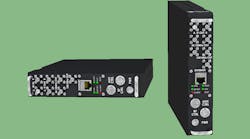Size and weight are critical parameters for many mission-oriented, in-field electronic devices being designed for smaller footprints. For wideband radios, the TAC-3290 family of broadband downconverters/tuners feature frequency coverage from 0.5 to 26.5 GHz (and extension to 44 GHz with an optional additional downconverter module) while fitting into a very low size, weight, and power (SWaP) form factor as an assist to mobile system designs. These compact modules were developed with the resulting combination of resources following Mercury Systems’ acquisition of Syntonic Microwave in 2019.
The family of compact downconverters/tuners include the single-channel model TAC-3290 and the dual-channel model TAC-3294 (see figure). They include internal low-phase-noise 100-MHz reference oscillator that can be phase-locked to an external 10-MHz reference. Both downconverters/tuners provide selectable bandwidths of 50, 1000, and 2000 MHz and intermediate-frequency (IF) outputs that are tunable in 10-kHz steps from 0.5 to 4.5 GHz. Versions are available for RF input ranges of 0.5 to 18.0 GHz and 0.5 to 26.5 GHz. By adding the FXTX downconverter, the RF input range can be extended to 44 GHz. The low-SWaP subsystems provide IF gain that can be adjusted from 10 to 50 dB in 1-dB steps. Multiple phase-coherent configurations are available with all downconverters/tuners equipped with RS-232C and Ethernet ports for remote computer control. The low-SWaP designs make it possible to bring broadband radio coverage to hostile environments and to installations where space is limited.
